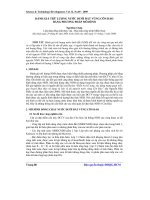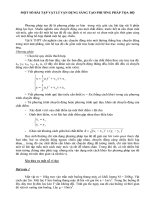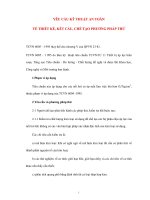Đào tạo phương pháp 8D training
Bạn đang xem bản rút gọn của tài liệu. Xem và tải ngay bản đầy đủ của tài liệu tại đây (2.13 MB, 78 trang )
• Problem Described Incorrectly – problem description
was not clear enough or thorough enough to focus the
Team on solving the correct issue.
• Problem-Solving Effort Rushed – to move quickly, steps
in the problem-solving process are skipped.
• Poor Team Participation – team members do not
participate effectively, so team failed to consider all
the causes (lack of cross-functional expertise).
• No Logical Process – A disciplined system to prioritize,
analyze, and review data/information was not used.
• Lack of Technical Skills – Statistical and problemsolving methods are not known by team members.
• Management Impatience – Due to lack of knowledge
of the problem-solving process, management
demands to know exactly when a problem will be
solved. This pressure causes the team to make an
inadequate analysis.
• Misidentified Root Cause – A potential cause is quickly
identified as a root cause, concluding the problem
investigation. However, the problem returns since the
true root cause was not eliminated.
• Permanent Corrective Actions Not Implemented –
Although a root cause may be identified, action is
taken to fully implement the permanent corrective
actions. These actions often require management to
approve costs and implement.
• Reactive (8D, 10-step)
o Activities undertaken to respond to a specific
Customer complaint (e.g. – product return) where a
corrective action response is requested
• Proactive (A3)
o Activities undertaken to address performance gaps
identified by data analysis (e.g. – key metrics)
• Day-to-Day (“quick kills”) - PDCA
o “Just do it” activities (e.g. – equipment breakdown)
o No team required
It is short for “Eight Disciplines,” which are eight distinct steps of a
systematic process for solving problems.
Where does it come from?
There are several problem-solving approaches available, such
as Kepner-Tregoe, the Deming Cycle, A3, PDCA, etc. Ford Motor
Company combined many of the successful elements from these
into their Team Oriented Problem Solving (TOPS) Workshop, which
this approach is based on.
Corrective action reporting from many diverse customers requires
applying the 8D approach.
8D = TOPS
• Predicated on team approach.
• Use for a cause-unknown situation (all significant
problems, not just Customer Returns)
• Fact-based, data-driven decision making. “If you
can’t prove it, don’t say it!”
• Eliminate the Problem, not the Symptom
• Requires action planning and documentation for
each step of the process.
• Focus on effectively using the process, NOT on writing
the report.
• Keep an open mind – facts/data will guide us
Establish a team of people with product and
process knowledge, skill in the various technical
disciplines, and allocated time and authority to
implement actions to solve a problem.
Supporting Concepts and Methods
• Employee involvement/participative
• Team leadership skills
• Meeting facilitation skills
Members
Good team members are persons who are:
1. Willing to contribute
2. Capable of diagnosing problems
3. Trainable in the use of improvement methods
4. Team players, rather than individual participants
Team size
3 to 7 people is optimum. With fewer than 3 members,
creativity and skills are limited and with more than 7 the
team is too large for effective team dynamics.
o Experts with specific skills can be rotated in and out of the team
as their skills are needed.
Multi-discipline Project Teams
• Identify the expected time commitment from team
members and ensure availability
– Management support needed
• Goals must be clearly specified, quantifiable, and
supported by all.
Doing business today is
tougher than ever:
• more demands
• complex problems
• Need to avoid wasted
money, time, and effort.
A team of individuals can
combine their skills/
knowledge to solve these
problems that are beyond
the capability of any one
person to solve alone.
• No leader empowered to implement ideas
• No champion assigned or available to assist the
team in time of need
• Personality conflicts, domination by one member,
negative attitudes (Why am I here?)
• Excessive management expectations, not enough
time
• Insufficient problem solving skills by members
• Undefined progress – No sense of urgency, no goals
• Lack of data/facts, not shared by all
“If you don’t know where you’re going, any road will get you there”
“If there’s a doubt, then there is no doubt…Get the FACTS!!”
To define the extent of the problem and its
effects in quantifiable terms, resulting in a
narrower focus for containment and root
cause-finding efforts.
Supporting Concepts and Methods
• 5W2H
• Is/Is Not Analysis
• Check Sheets
• Pareto Diagrams
• Control Charts
“A problem well stated is a problem half-solved.”
Charles Kettering
• Rarely will a problem description be complete/final at
the beginning of the 8D process
• Problem cannot be completely described until it is
well understood
– Problem Description should be revised and
updated to incorporate new facts/data
• Quantify the gap between what “is” and what
“should be”
1. Customer Complaint
2. 5W2H
3. Data Collection
4. Comparative Analysis
a. Is/Is Not
b. Table of known facts
5. Formulate Problem
a. Flow diagram
Statement
b. Collect Data (attribute
a. Include benchmark
and variable)
c. Stratify (check sheets
b. Incorporate all
and paretos)
important facts
d. Statistical data (SPC,
c. Concise and precise
Cpk, etc)
• Describe the symptoms experienced by the customer
(user) in their terms.
• Ensure the complaint is clearly and fully understood
o Direct customer contact (ask clarifying questions)
o Customer representatives may be on the team
o Understand the problem from the customers’
viewpoint
Characterize the problem for further analysis through 5W2H:
Who?
Identify who is associated with the problem.
Which customer(s) are complaining? Which
internal group(s) are complaining?
What?
Describe the problem adequately. What is the
defect and gap from “target”? What part or object
is involved? Does the severity of the problem
vary?
Where? If the defect occurs on a part, where is the defect
located? Use a location check sheet. Where was
the defect found (geographically)? What is the
geographic distribution of complaints?
When? Identify the time when the problem started and
past history (trends). Do all production shifts
experience the same frequencies? What time of
the year does the problem occur? When did the
nonconformance occur? What was operating time?
What shift? What season?
Why?
Define why this is a problem for the Customer or
organization. Translates “how big” (see next slide)
into total business impact.
How?
In what mode of operation was the problem
discovered? What procedures were being
used? What environmental conditions were
present?
How Big? Quantify the extent and severity of the
problem (quantity, percent, cost, DPPM, etc)
Search:
Search for a comparative basis (act like a detective,
include similar parts/situations). Put boundaries around
the problem to narrow the search for a root cause. Ask
numerous questions and gather as much data as
possible to establish the “facts” of the problem.
• Who is experiencing the
problem?
• Where was the discrepancy
observed?
• Where on the part is the
defect?
• When was the issue
observed?
• How many bad parts are in
the system?
• Who could be experiencing the
problem but is not?
• Where could the issue have
been observed but was not?
• Where on the part could the
defect be but is not?
• When could the issue have
been observed but was not?
• How many bad parts could be
in the system but are not?









